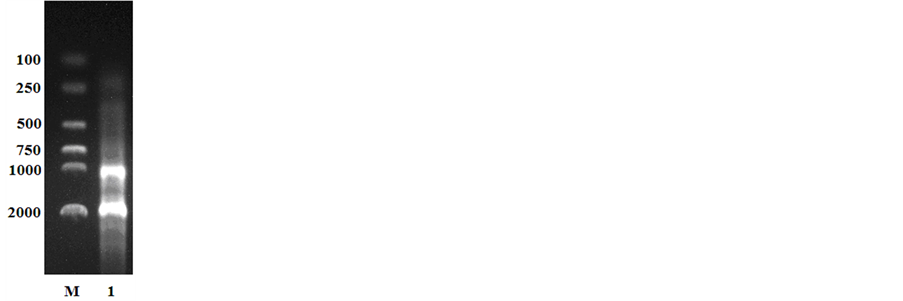摘要:
解偶联蛋白-1 (UCP1)是分布于线粒体内膜上的一种产热蛋白,其主要功能是参与褐色脂肪组织(BAT)的产热调节和能量代谢来维持机体的能量代谢平衡。本研究通过设计简并引物进行反转录聚合酶链式反应(RT-PCR),从中缅树鼩(Tupaia belangeri)BAT中成功获得444 bp UCP1 cDNA核心片段。推测其氨基酸序列为148个氨基酸;经结构功能分析发现,此段氨基酸序列具有32 bp UCPs 共同具有的同源序列,具有13 bp中缅树鼩BAT UCP1的特异性序列;进行氨基酸同源性序列比较分析表明,中缅树鼩与小家鼠、褐家鼠、灰仓鼠、家兔、马、猫、牛、海象、黑猩猩和大熊猫UCP1的同源性分别为80%、81%、82%、86%、85%、86%、89%、87%、83%和88%。结果表明:UCP1编码区在哺乳动物中具有较高保守性,提示UCP1在脊椎动物中扮演着重要的生理角色。
Abstract: Uncoupling protein-1 (UCP1) is a kind of heat producing protein, which distributes on the inner membrane of mitochondria. Its main function is to maintain the body’s energy metabolic balance by participating thermogenic regulation and energy metabolism in BAT. In this study, we designed primers and used reversing transcriptase polymerase chain reaction (RT-PCR). This experiment successfully obtained 444 bp BAT UCP1 cDNA core fragment of tree shrews, and we speculated that the amino acid sequence were 148 amino acids. After structure-function analysis, we found that fragment composed of these amino acid possessed 32 bp homologous sequence of UCPs and 13 bp specific sequence of UCP1 in Tupaia belangeri. After the comparison of amino acid sequence ho-mology, the results showed that the UCP1 homology between tree shrews and other animals like Mus musculus, Rattus norvegicus, Cricetulus griseus, Oryctolagus cuniculus, Equus caballus, Felis ca-tus, Bos taurus, Odobenus rosmarus, Pongo abelii and Ailuropoda melanoleuca was respectively 80%, 81%, 82%, 86%, 85%, 86%, 89%, 87%, 83% and 88%. UCP1 coding region showed higher conser-vation in mammals, suggesting that UCP1 plays an important physiological role in vertebrates.
1. 引言
解偶联蛋白(UCPs)是分布于线粒体内膜上的一类产热蛋白[1] 。其活性与热量散失紧密相关,受嘌呤核苷(ADP,ATP)、鸟苷(GDP,GTP)及游离脂肪酸(Free Fatty Acids, FFA)的调节,在哺乳动物产热和能量代谢调节中具有重要的作用[1] 。目前己发现主要有五种类型的UCP:UCP1、UCP2、UCP3、UCP4和UCP5。UCP1活性存在于哺乳动物褐色脂肪组织(Brown adipose tissue, BAT)中;UCP2则广泛分布于全身组织,如白色脂肪组织(White adipose tissue,WAT)、心、肝、肾、脾、甲状腺、胃肠等[2] ;UCP3主要分布于骨骼肌中[3] ;UCP4主要分布于神经组织中[4] ;UCP5主要存在于脑及神经组织中。这些蛋白质都属于线粒体载体族蛋白。后来又在啮齿类和人的大脑里发现存在一种与UCP3功能相似的线粒体载体蛋白,称为脑线粒体载体蛋白-1(BMCPl) [5] 。在马铃薯和拟南芥中也发现与哺乳动物UCPs类似的解偶联蛋白,即StUCP和AtUCP,可能与植物抵抗低温胁迫功能有关。近年来的研究大都支持UCPs作用于线粒体状态IV呼吸,引起呼吸解偶联或质子泄漏的观点[5] 。目前,不仅在哺乳动物和植物组织中发现有多种解偶联蛋白质(UCPl、UCP2、UCP3、UCP4、BMCP1、StUCP、AtUCP)存在,而且在原生动物、鱼类中均发现存在与哺乳动物和植物UCPs相类似的解偶联蛋白。因此UCPs可能存在于整个真核生物中[6] 。其中UCP1、UCP2、UCP3是决定哺乳动物线粒体解偶联过程的主要蛋白质,在哺乳动物产热和能量代谢调节中具有重要的作用。UCP1,可能还有UCP3主要决定了BAT和骨骼肌的非颤抖性产热能力;UCP2可能在调节体重和维持能量代谢平衡中起着重要的作用[7] 。
中缅树鼩属攀鼩目(Scandentia)树鼩科(Tupaiidae),该科动物主要分布于印度、尼泊尔、缅甸、苏门答腊、爪哇、婆萝洲,以及贝宁、菲律宾及其附近的岛屿[8] 。在国内主要分布于云南、广西、贵州、四川及海南岛等地,其中,云南是其主要的分布区[9] 。随着世界灵长动物资源的逐渐枯竭和生物医学实验动物小型化发展,自80年代以来,中缅树鼩已被广泛应用于各种生物医学研究,例如,现已广泛用于研究肝炎[10] ,尤其是研究丙肝病毒的感染机制[11] 。目前,对UCP的研究主要集中在人和鼠上,本研究从中缅树鼩BAT中成功获得了UCP1 基因cDNA核心序列,这将为脊椎动物UCP1基因结构与功能研究提供新信息。
2. 材料与方法
2.1. 实验动物
实验动物中缅树鼩捕自昆明禄劝县灌丛,该地区位于东经102˚13'~102˚575',北纬25˚26'~26˚22',海拔1679 m。该地区位于滇中高原北部,气候属于北亚热带高原气候,年平均温度为15.6℃;最热月(7月)平均气温19.8℃;最冷月(1月)为7.8℃[12] ,气温垂直变化明显,年温差较小,但是日温差较大。该地区地表起伏较大,地质地貌复杂。
2.2. 方法
2.2.1. BAT中总RNA的提取
将中缅树鼩断颈处死以后,分离出BAT,总RNA的提取与纯化按照RNApure高纯总RNA快速抽提试剂盒(BioTeke Co.)进行。用琼脂糖凝胶电泳检测RNA的纯度和完整性。RNA于−80℃保存。
2.2.2. cDNA第一链的合成
cDNA第一链的合成使用试剂盒,以BAT总RNA为模板,oligo (dT)18为反转录引物,按照M-MLV Frist Strand Kit试剂盒(Invitrogen Co.)推荐方法进行。按表1冰浴配制反应体系,反应完毕后,于−20℃保存。
2.2.3. UCP1基因cDNA核心序列的扩增
根据人、大鼠和小鼠等已知脊椎动物UCP1基因氨基酸序列的保守区域设计简并引物。以上述cDNA第一链为模板进行RT-PCR,扩增条件为:94℃变性5 min,94℃30 s,53~58℃1 min,72℃1 min,共37个循环,72℃延伸10 min。扩增体系为25 μL:其中包括1 μL Template (10 ng/μL),2.5 μL 10 × PCR Buffer,1 μL MgCl2 (25 mmol/L),2 μL dNTPMixture (10 mmol/L, pH 8.0),1 μL Primer 1 (10 pmol/μL),1 μL Primer 2 (10 pmol/μL),0.5 μL Taq enzyme (4 U/μL),16 μL ddH2O。
2.2.4. 数据处理
对于获取的UCP1基因cDNA序列,用美国国家生物技术信息中心(NCBI, National Center for Biotechnology Information, http://www.ncbi.nlm.nih.gov)网站的BLAST软件进行同源性比对,采用MEGA5软件[13] 中的ML法与GenBank数据库中已公布的不同来源的UCP1基因cDNA序列构建系统进化树,系统树各分支的数值由500次重复检验所得;用ORF软件(http://www.ncbi.nlm.nih.gov/gorf/)推导编码蛋白的氨基酸序列。
3. 结果与分析
3.1. BAT中总RNA的提取
根据Bioteke公司的Total RNA Isolation Kit试剂盒说明书提取中缅树鼩BAT总RNA,并以0.8%琼

Table 1. The reaction system of cDNA synthesis for first chain
表1. cDNA第一链合成反应体系
脂糖凝胶电泳检测,结果见图1。
3.2. UCP1基因cDNA核心序列
以中缅树鼩BAT总RNA为模板,根据M-MLV第一链cDNA合成试剂盒说明书合成cDNA第一链,根据已经报道的人、鼠、犬等哺乳动物UCP1序列的保守区域,设计引物,再分别以上述cDNA第一链为模板,进行RT-PCR合成cDNA,进行琼脂糖电泳检测,获得产物片段,结果见图2。
3.3. UCP1 RT-PCR 产物的测序及分析
送UCP1 RT-PCR所得产物,进行正反两个方向的序列测定,结果得到一个444 bp的中缅树鼩BAT UCP1 cDNA核心片段,推测其氨基酸序列为148个氨基酸。经结构功能分析发现,此段氨基酸序列具有32 bp UCPs共同具有的同源序列,具有13 bp中缅树鼩BAT UCP1的特异性序列(图3)。
3.4. UCP1氨基酸序列的同源性分析
哺乳类动物完整的UCP1一级结构由306个氨基酸残基构成,含有6个外显子和5个内含子。中缅树鼩与小家鼠、褐家鼠、灰仓鼠、家兔、马、猫、牛、海象、黑猩猩和大熊猫UCP1的同源性分别为80%、81%、82%、86%、85%、86%、89%、87%、83%和88%(图4),表明UCP1编码区在哺乳动物中具有较高保守性,提示UCP1在脊椎动物中扮演着重要的生理角色。
3.5. UCP1 系统进化分析
我们利用NJ法运算500次建立系统进化树,将扩增得到的UCP1序列与小家鼠(Mus musculus NM_009463.3)、褐家鼠(Rattus norvegicus NM_012682.2)、金仓鼠(Mesocricetus auratus NM_001281332.1)、绵羊(Ovis aries JN604985.1)、野猪(Sus scrofa NG_005757.1)、小耳大婴猴(Otolemur garnettii XM_003790181.1)、普通狨(Callithrix jacchus XM_002745333.1)、猕猴(Macaca mulatta XM_001090457.2)、智人(Homo sapiens NG_012139.1)、鲫鱼(Cyprinus carpio AY461434.2)UCP1序列构建系统进化树,由图5可以看出褐家鼠、小家鼠和金仓鼠聚在一起,形成啮齿目分支;绵羊和野猪聚在一起形成偶蹄目分支;鲫鱼单独聚为一支;中缅树鼩与小耳大婴猴、普通狨、猕猴和智人聚为灵长目分支。说明中缅树鼩的亲缘关系更接近灵长目。
4. 讨论
研究指出UCP1的一级结构由306个氨基酸残基构成,具有6个由α-螺旋构成的疏水环的过渡区域

Figure 1. Total RNA electrophoregram of Tupaia belangeri
图1. 中缅树鼩总RNA电泳图
注:M:Marker;1:BAT中总RNA;
Note: M: Marker; 1: the total RNA of BAT

Figure 2. The electrophoregram of RT-PCR products
图2. RT-PCR产物电泳图
注:M: marker;1:BAT中UCP1;
Note: M: Marker; 1: the UCP1 of BAT
[5] [7] [14] 。解偶联蛋白基因与人类多种疾病相关,如糖尿病、肝病、神经系统疾病等[15] 。UCP1主要分布于BAT,对于线粒体载体家族成员的晶体结构、腺嘌呤核苷酸转位酶的研究主要集中在UCP1,UCP1基因分析结果表明UCP1基因具有很高的保守性。UCP1基因具有6个外显子,其中包括了编码序列,每个外显子都可以编码蛋白质的穿膜域[16] 。我们的研究通过RT-PCR得到444 bp的中缅树鼩BAT UCP1 cDNA核心片段,推测其氨基酸序列为148个氨基酸。经结构功能分析发现,此段氨基酸序列具有32 bp UCPs共同具有的同源序列,具有13 bp中缅树鼩BAT UCP1的特异性序列,与多种哺乳动物UCP1基因同源性比较发现,其氨基酸序列的同源性高达80%以上。
本研究通过对中缅树鼩UCP1基因结构、功能、系统进化地位的系统分析,探索了中缅树鼩UCP1在其产热、脂肪代谢等生理机能中的重要作用。此外,UCP1基因组织表达模式的调控也值得进一步研究。现在己知UCP1序列的哺乳动物中,BAT UCP1的同源性非常高,达到99%以上。中缅树鼩BAT UCP1分子量与人,大鼠,小鼠非常近似。至于一级结构全序列同源性还有待于对中缅树的BAT UCP1氨基酸序列及相关基因序列进一步研究。对氨基酸序列同源性进行研究,能为树鼩科动物在系统演化或进化树上的定位提供意义重大的数据。因此,进一步对中缅树鼩UCP1蛋白质的一级结构,空间晶体结构,核

Figure 3. The partial nucleotide sequence of Tupaia belangeri uncoupling protein 1 cDNA and putative amino acid sequence. The consensus sequence of UCPs is boxed, The special sequence of UCP1 in Tupaia belangeri is underlined
图3. 中缅树鼩UCP1基因cDNA部分序列及其推导的氨基酸序列。方框内为UCPs共有序列,下划线为中缅树鼩BAT UCP1的特异性序列

Figure 4. The comparison of amino acid sequence homology of UCP1 gene between tree shrews and other mammals. * indicated the same amino acid; a period indicates semiconservative substitutions
图4. 中缅树鼩与其他哺乳动物UCP1基因氨基酸序列同源性比较。*表示相同氨基酸,. 表示半保守序列替代物

Figure 5. Phylogenetic tree of UCP1 gene. Phylogenetic tree obtained using MEGA5 software by ML method. The value at the nodes presents the bootstrap value using 500 bootstrap replications
图5. UCP1系统进化树. MEGA5软件中的ML方法建树,枝上数值表示500次重复抽样所得的支持率
酸序列,基因结构,甚至在核苷酸突变、UCP1基因人工去除等方面进行深入研究,将为树鼩科动物及相关类目动物的系统学分类提供更为有力的分子生物学证据。
综上所述,本研究中,中缅树鼩UCP1氨基酸同源性分析结果表明,UCP1基因编码区在哺乳动物中均具有较高保守性,揭示了UCP1在脊椎动物中扮演着重要的生理角色,其可能在产热和能量代谢调节中具有重要的作用。
致谢
感谢国家国际科技合作专项项目(2014DFR31040);十二五科技支撑项目(2014BAI01B00);国家自然科学基金项目(No.31360096; No.31260097);云南省应用基础研究计划重点项目(No. 2013FA014)的支持。

NOTES
*第一作者。
#通讯作者。